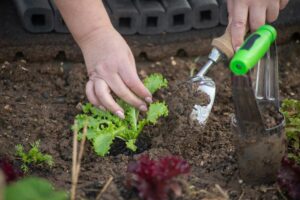By this point in our overworked and over-stressed lives, we might already know that exercise and good food are the foundations of well-being. However, some activities can blend it all and be close to home. There are many health benefits to gardening. But embarking on a journey to a flourishing yard begins beneath the surface, with the earth. Understanding soil health for thriving gardens is essential for any gardener, novice or experienced. In this comprehensive guide, we dive into what is good ground and how to nurture it. You’ll learn about enhancing fertility, managing moisture, and selecting the right plants for your soil type. Let’s unearth the secrets of healthy soil together!
Grasping the essentials of soil health is pivotal in cultivating a lush and productive garden. First, soil combines minerals, organic matter, air, and moisture. These components are vital for plant health, influencing root growth and nutrient absorption. The texture and structure of your soil, whether sandy, loamy, or clay, also play a significant role in its ability to support plant life.
When embarking on the journey of relocating, especially to a new home with an unfamiliar garden, understanding the health of the soil can feel like solving a mystery. In such times of transition, entrusting your move to Lindo Removals can be a game-changer. Specialising in seamless transitions, they expertly manage everything from household to office relocations and removals. By delegating the intricacies of the move to these professionals, you gain the freedom to concentrate on crucial tasks like assessing and amending your new garden’s soil or maintaining the vitality of your current one. With Lindo Removals, your relocation becomes not just a change of address but an opportunity for seamless continuity in your gardening pursuits.
After you finish settling into your new place, conduct simple soil tests to determine your soil’s pH level and nutrient content. Such tests identify what types of plants will thrive and what amendments are necessary to correct any imbalances. For new gardens, begin by removing weeds and debris. Then, incorporate organic matter, such as compost, to improve soil fertility and structure. This process helps build a strong foundation for healthy, flourishing plants.
Boosting your garden’s soil fertility is key to nurturing healthy, vibrant plants. There are various ways to enrich your garden’s foundation effectively. Adding compost or aged manure enriches the soil with essential nutrients. These amendments improve texture, aiding in water retention and aeration. You can also be eco-friendly with natural fertilisers to provide additional nutrients. Options like bone meal or fish emulsion can offer a sustainable, effective nutrient boost.
Importantly, the pH level of your garden greatly influences plant health. Use lime to raise the pH or sulfur to lower it, ensuring an optimal environment for your plants. Periodic testing helps monitor fertility levels, guiding your maintenance and amendment strategies to keep your garden thriving. If you feel that chemical testing is too much of a hassle, there are other ways to get a rough estimation:
Proper moisture and drainage are important in fostering soil health for thriving gardens. Effectively managing these aspects contributes to optimal plant health. Specifically, regularly check your garden’s moisture content. The feel test involves squeezing a handful of earth—if it forms a ball without dripping water, the moisture is likely adequate. Good drainage prevents water-logging, which can harm plant roots. To enhance drainage and aeration, incorporate coarse sand or organic matter for compacted or clay-heavy areas.
What’s more, efficient watering practices contribute significantly to moisture management. Deep, less frequent watering encourages strong root growth. Consider drip irrigation for consistent, targeted watering. Applying mulch also helps retain moisture and regulate temperature. Organic mulches, like straw or bark chips, gradually enrich the garden as they decompose.

The amount of water your soil gets vs. what it needs can greatly affect how your plants will thrive.
Matching plants to your garden’s conditions is key for thriving vegetation. This approach creates a symbiotic relationship between the plants and their environment. Each plant has unique needs in terms of nutrient, moisture, and pH levels. Researching these preferences helps select plants that naturally flourish in your garden’s conditions. Also, determine whether your ground is sandy, loamy, or clay. Sandy areas drain quickly and may suit drought-tolerant plants, while clay-heavy areas retain more moisture, suitable for plants that need consistent hydration.
If you have favorite plants unsuited to your current garden conditions, consider making small adjustments. Adding compost can improve nutrient content while altering pH levels can make the environment more hospitable for specific plant types. However, keeping local greenery or some that have already adapted over many years is usually a good idea. That helps protect the endemic flora and fauna, not to mention it attracts pollinators and beneficial insects.

A good topsoil and, thus, a good garden is reflected in its buzzing visitors.
Maintaining the health of your garden’s foundation is an ongoing task. Effective and regular soil care ensures the longevity and vitality of your plants. So, make sure to adapt your maintenance routine to the changing seasons. In spring, aerate compacted areas to improve oxygen flow. During fall, add compost or mulch to replenish nutrients.
For thriving gardens, regularly test your soil health. That includes checking pH levels and nutrient content and observing changes in plant health or soil structure. Based on these findings, adjust your care strategy.
In addition, control weeds and pests, as they can affect soil quality and plant health. Use organic methods where possible to keep the ecosystem balanced and healthy. Periodically add organic matter like compost or aged manure to enrich the soil. This practice boosts nutrient levels and enhances soil texture, promoting robust plant growth.
The journey to a flourishing garden begins with understanding and nurturing the foundation beneath our feet. By embracing practices that promote soil health for thriving gardens, you can witness your garden transform into a vibrant, thriving ecosystem. Regular testing, appropriate plant selection, and attentive maintenance are key. Whether you’re a seasoned gardener or just starting out, these tips will help guide your efforts toward creating a sustainable, beautiful garden space. Happy gardening!